Matter
responds highy noninlearly
to an intense laser field, generating high-harmonics, i.e, radiation
whose frequency is a multiple of that of the driving field. These
harmonics exhibit a region with comparable intensities, the
so-called "plateau", followed by a sharp decrease in the yield,
the so-called "cutoff".
It is well-known that high-order harmonic generation is the result of a three-step physical mechanism in which an electron reaches the continuum by tunneling of multiphoton ionization, propagates in the field and recombines with a bound state of its parent ion, generating harmonics.
The above-mentioned three steps can be manipulated with the purpose of controlling the high-order harmonic spectrum. We have extensively studied these possibilities by employing bi- or multicrhomatic driving fields, additional binding potentials, or, more recently, an attosecond-pulse train.
This work has been developed in the course of many years, using methods such as the time-dependent Schroedinger equation, windowed Fourier transforms and the strong-field approximation, in collaboration with many groups such as the Max Born Institute, Berlin, Max Planck Institut for Physics of Complex Systems, Dresden, ICFO Barcelona and CEA Saclay.
Details on my early work can be found here
Quantum interference effects in molecules
In molecules in strong fields, the electron may recombine with spatially separated centers. Quantum mechanically, these processes will interfere, so that the structure of a molecule hides in the interference maxima and minima present in the spectra. In our recent work, we have investigated such processes semi-analytically using saddle-point methods
As a starting point, we looked at one- and two-center processes in diatomic molecules. In the former case, the electron leaves from and recombines with the same center, whereas in the latter, it leaves from one center and recombines with the other. We found that the relevant interference occurred between the processes starting at the same center in the molecule, regarless where recombination takes place. We have also mapped the interference patterns from the length to the velocity gauge by appropriately dressing the initial and final bound states.
Subsequently, we developed models beyond the single orbital and single active electron approximation, in order to assess their influence on the high-order harmonic spectra. We employed both a simplified multielectron model employing the HOMO and the HOMO-1 in N2 and a coherent superposition of the HOMO and the LUMO in N2+. We found that, due to its geometry, the HOMO plays a more important role than the HOMO-1 by determining the features in the spectra in the parameter range of interest. Furthermore, for the coherent superposition of the HOMo and LUMO, different orbitals are mapped into different regions in the spectra.
We have also incorporated multielectron effects in HHG using Moller-Plesset perturbation theory around the HOMO, both for homonuclear and heteronuclear molecules, and made a detailed assessment of i results obtained for different formulations of the strong-field approximation in this context. Further studies include the distortions of nodal structures for heteronuclear molecules and their influence on the high-order harmonic spectra.
This work is currently being developed at UCL together with Brad Augstein.
It is well-known that high-order harmonic generation is the result of a three-step physical mechanism in which an electron reaches the continuum by tunneling of multiphoton ionization, propagates in the field and recombines with a bound state of its parent ion, generating harmonics.
Control of high-order harmonic generation
The above-mentioned three steps can be manipulated with the purpose of controlling the high-order harmonic spectrum. We have extensively studied these possibilities by employing bi- or multicrhomatic driving fields, additional binding potentials, or, more recently, an attosecond-pulse train.
This work has been developed in the course of many years, using methods such as the time-dependent Schroedinger equation, windowed Fourier transforms and the strong-field approximation, in collaboration with many groups such as the Max Born Institute, Berlin, Max Planck Institut for Physics of Complex Systems, Dresden, ICFO Barcelona and CEA Saclay.
Details on my early work can be found here
Quantum interference effects in molecules
In molecules in strong fields, the electron may recombine with spatially separated centers. Quantum mechanically, these processes will interfere, so that the structure of a molecule hides in the interference maxima and minima present in the spectra. In our recent work, we have investigated such processes semi-analytically using saddle-point methods
As a starting point, we looked at one- and two-center processes in diatomic molecules. In the former case, the electron leaves from and recombines with the same center, whereas in the latter, it leaves from one center and recombines with the other. We found that the relevant interference occurred between the processes starting at the same center in the molecule, regarless where recombination takes place. We have also mapped the interference patterns from the length to the velocity gauge by appropriately dressing the initial and final bound states.
Subsequently, we developed models beyond the single orbital and single active electron approximation, in order to assess their influence on the high-order harmonic spectra. We employed both a simplified multielectron model employing the HOMO and the HOMO-1 in N2 and a coherent superposition of the HOMO and the LUMO in N2+. We found that, due to its geometry, the HOMO plays a more important role than the HOMO-1 by determining the features in the spectra in the parameter range of interest. Furthermore, for the coherent superposition of the HOMo and LUMO, different orbitals are mapped into different regions in the spectra.
We have also incorporated multielectron effects in HHG using Moller-Plesset perturbation theory around the HOMO, both for homonuclear and heteronuclear molecules, and made a detailed assessment of i results obtained for different formulations of the strong-field approximation in this context. Further studies include the distortions of nodal structures for heteronuclear molecules and their influence on the high-order harmonic spectra.
This work is currently being developed at UCL together with Brad Augstein.
